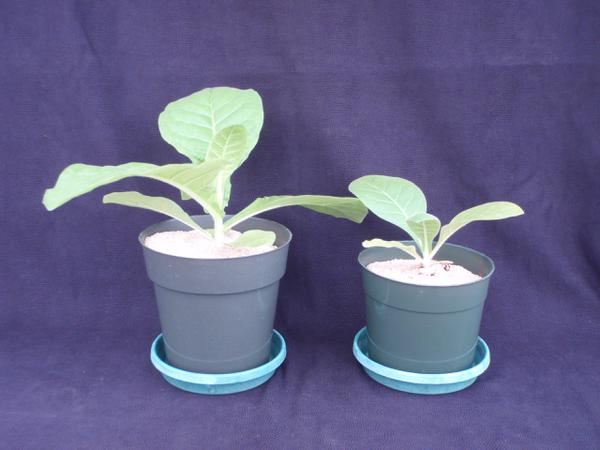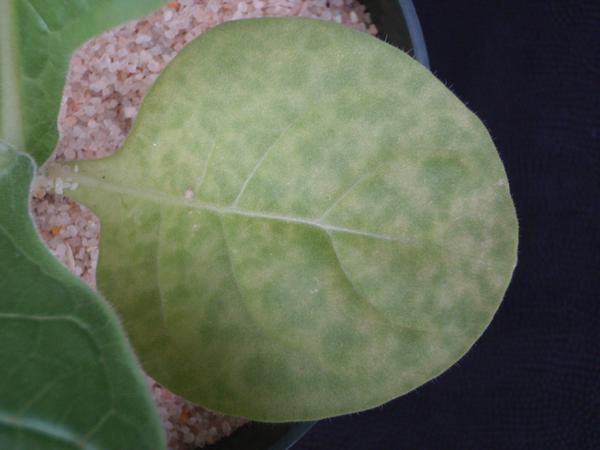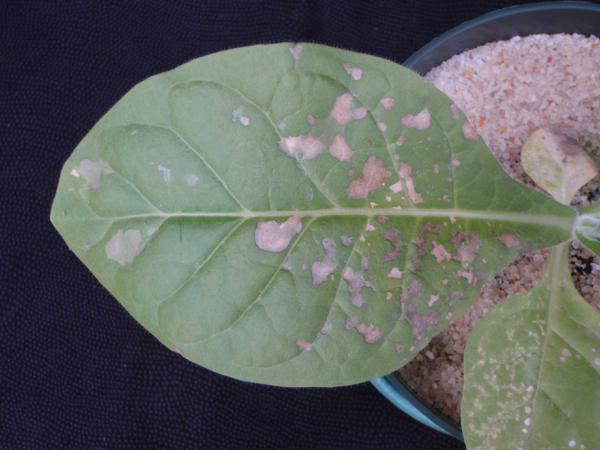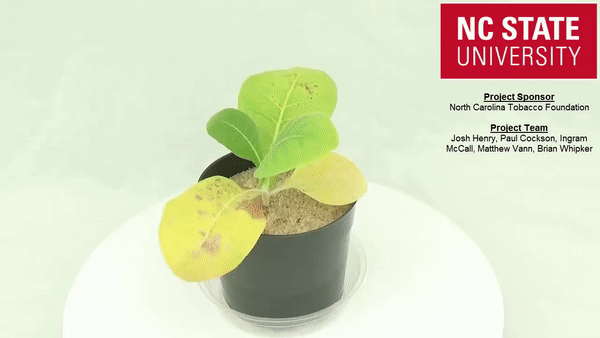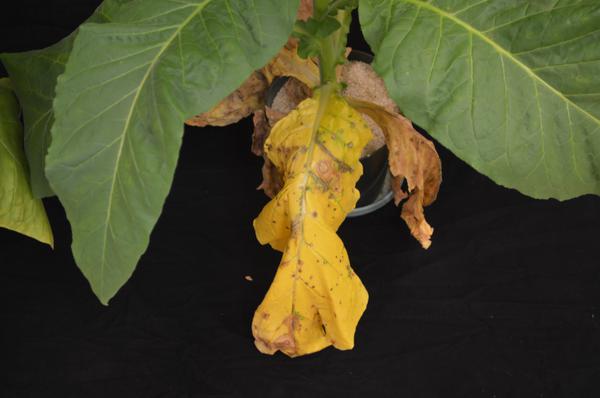Phosphorus Deficiency
Phosphorus (P) deficiency in tobacco begins as a noticeable stunting when compared to a plant with a sufficient supply of P. Additionally, a P deficient tobacco plant may develop a darker green coloration of the upper foliage. Lower leaves will become chlorotic with a mottling of olive green leaf spots. The initial symptoms appearing on the lower foliage may be attributed to the fact that P is mobile within plant tissues and is translocated from these older leaves to the young developing tissues under periods of low P.
- Type
- Nutrition
- Leaf Location
- Older
- Leaf Condition
- Complete necrosis, Spotting - brown
- Leaf Color
- Green - dark dull, Necrosis (brown)
- Roots
- Elongated
- Plant Size
- Stunted
Problem
Nutritional disorder – phosphorus (P) deficiency.
Symptoms
Being one of the three primary macroelements required for plant growth, phosphorus (P) deficiency symptoms develop quickly when phosphorus is in short supply.
Phosphorus deficiency in tobacco begins as a noticeable stunting when compared to a plant with a sufficient supply of phosphorus (Figure 1). Additionally, a phosphorus deficient tobacco plant may develop a darker green coloration of the upper foliage. Lower leaves will become chlorotic with a mottling of olive green leaf spots (Figure 2). The initial symptoms appearing on the lower foliage may be attributed to the fact that phosphorus is mobile within plant tissues and is translocated from these older leaves to the young developing tissues under periods of low phosphorus.
As symptoms progress, the leaves begin to develop sunken necrotic spots over the leaf surface (Figure 3). The lower leaves which were previously mottled in appearance become evenly chlorotic with necrotic spotting. These necrotic spots form first on the lower leaves and later on the younger foliage. With these intermediate symptoms, the upper foliage has an olive green appearance.
Figure 5 exhibits symptoms of phosphorus deficiency in a float system.
In advanced cases, the plant is still severely stunted, with the oldest leaves becoming entirely necrotic. The chlorosis and necrotic spotting works its way up the foliage with only the youngest leaves remaining green. This wide range of symptoms may be observed in the 360-degree image below (Figure 4). Figure 6 show a plant with advanced symptoms.
Similar Problems
Nitrogen deficiency can also result in stunted plant growth, but in the case of limited nitrogen, the lower leaves have an overall light green to yellow coloration. Tissue analysis for nutritional concentration can assist with correct diagnosis.
Additional Information
Good root systems and environmental conditions will aid in the uptake of phosphorus.
Diagnostic Tips
Submit a leaf sample for nutrient analysis.
Burley. The phosphorus sufficiency range for burley tobacco is similar for all growth stages (seedlings, early growth, flowering and maturity): 0.2 to 0.5% phosphorus. The range is based on sampling the most recently mature leaves.
Flue-cured. The recommended ranges for flue-cured tobacco are more refined. The phosphorus ranges based on the most recently mature leaves are: seedlings (0.2 to 0.5%), early growth (0.2 to 0.5%), flowering (0.2 to 0.5%) and maturity (0.17 to 0.5%). At harvest, sufficiency ranges for phosphorus are available for the upper leaf (0.14 to 0.3%), middle leaf (0.13 to 0.3%) and lower leaf (0.12 to 0.3%).
There are no published recommendations for excessive phosphorus levels, although excess phosphorus can tie up iron (Fe) and zinc (zinc).
Corrective Measures
Phosphorus availability is typically not a limiting production factor in areas with a history of tobacco production due to years of excessive application. However, soil reserves can be low in fields new to agricultural production; therefore, routine soil analysis should be used to determine nutrient need prior to production. If phosphorus deficiency is confirmed in leaf tissue after transplanting, 20 to 40 pounds of P per acre from triple super phosphate (0-46-0) banded near plants should correct the issue in most systems. More may be required in specific soil types where soil chemistry renders applied phosphorus unavailable. In most cases, where P is not truly limiting, improved environmental conditions (warmer and drier soils) will promote plant root growth and the issue should correct itself.
Management
Seedling Production. It is recommended that no more than 40 to 50 ppm phosphorus be applied to the floatbed for adequate seedling growth. Excess phosphorus will reduce seedling quality as plants will become “leggy” and spindly due to decreased stem diameter and increased stem length. Producers are encouraged to select fertilizer sources with a 2:1:2 or 3:1:3 nutrient ratio to prevent over application. Phosphorus deficiency has been observed in the float system; however, it is rare and typically occurs when fertilizer sources absent of phosphorus are applied or when the first fertilizer application is delayed beyond 15 days after seeding.
Field Production. Phosphorus is not very leachable, even in sandy soils, and a good tobacco crop only removes about 15 pounds per acre (as P2O5). However, many times this amount has been applied to tobacco fields over the years, resulting in at least “high” levels of available phosphorus in about 85 percent of the fields used for tobacco. Under this soil condition, no more than 5 pounds of phosphorus in the transplant water is sufficient to promote early season growth, specifically when cool, damp soil conditions are present just after transplanting. Applying a reduced rate of phosphorus in the transplant water greatly increases phosphorus use efficiency while reducing the risk of runoff into nearby bodies of water. In addition, phosphorus continues to be one of the more expensive nutrients required for crop production in general; therefore, reduced application rates for tobacco production will also reduce the cost of a desired fertility program.
Funding Source
Funding was provided in part by the North Carolina Tobacco Foundation.
Project Team
Josh Henry (NC State M.S. student in Horticultural Science), Paul Cockson (NC State B.S. student in Agroecology), Ingram McCall (Research Technician in Horticultural Science), Rhonda Conlon and Rob Ladd (Extension IT at NC State), Matthew Vann (Tobacco Extension Specialist, Dept. of Crop and Soil Sciences), and Brian Whipker (Professor of Floriculture and Plant Nutrition in Horticultural Science).



